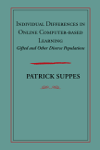

|
|
|
|

Individual Difference in Online Computer-based LearningGifted and Other Diverse Populations In 1894 John Dewey established his experimental laboratory school at the University of Chicago, with a focus on teaching each student according to their individual differences. This concept indicated a shift away from the emphasis on communal, classroom teaching, which marked educational practices in the nineteenth century during the advent of widely available public education. With the introduction of computer-based online instruction in schools, curricula are able to be fully informed by individual difference, subtly and quickly tracking students' progress. In these courses, teachers play the role of troubleshooters instead of lecturers. Individual Differences examines a large number of studies on computer-based and online instruction, with special attention paid to gifted students in the fields of mathematics, science, technology, and engineering. Other chapters also focus on a wide variety of student populations: deaf students, American Indian rural students, and underachieving, impoverished students. (1922–2014) was Lucie Stern Professor of Philosophy, Emeritus, at Stanford. Contents
October 2013 ISBN (Paperback): 9781575866246
|
Distributed by the
University of Chicago Press |
|
pubs @ csli.stanford.edu
|
CSLI Publications
Stanford University Cordura Hall 210 Panama Street Stanford, CA 94305-4101 (650) 723-1839 |